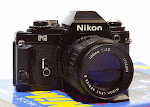What is hyperfocal?
Hyperfocal is a setting on your lens, which give you the greatest possible depth-of-field.
Example: When you need everything in relatively sharp focus from a few feet away all the way out to hundreds of feet away.
Lets take a look at how you set your lens for hyperfocal.
1. Set your lens to the smallest aperture it will allow.
2. Center the infinity marker above the right handed smallest marking on the depth of field scale.
Look at the photo below of the manual focus 28mm lens. The aperture is set to its smallest setting f/22; the infinity marker is placed above the 22 on the depth-of-field scale. This brings infinity just within the depth-of-field and provides the greatest depth of field with this lens set at f/22.
The lens will now perform at it’s greatest depth-of-field, which is about 2 ½ feet to infinity. This is the maximum depth-of-field this lens will provide.

Take another look at the photo above; you will notice that the distance scale reads about 4 feet. This is the hyperfocal distance for this lens at f/22.
If light is an issue and you need to open the aperture a stop or two, this is no problem. Simply follow the previous steps: try using f/8 or any f/stop and see what you get.
F/8 will give you a distance of about 5 feet to infinity on the lens above. If you didn’t come up with that answer reread the information and try again.
APERTURE PRIORITY / SHUTTER PRIORITY
Every time we take a photo we need to decide on depth-of-field. How will the depth-of-field affect your photo, will a deep depth add strength to the composition or perhaps a shallow depth would be more appealing?
Many cameras have automatic exposure settings be it film or digital cameras. You can use these exposure settings to your advantage.
The two main settings are as follows:
1. Aperture Priority – You select the aperture and the camera automatically sets the shutter speed.
2. Shutter Priority – You select the shutter speed and the camera automatically set s the aperture.
Aperture priority allows you to maintain creative control of your image because you select the aperture and can decide on the depth-of-field you want.
Shutter priority offers no direct control over depth-of-field. The camera will choose the aperture for you. There is a trick you can use to overcome this; I will talk about this later.
Many cameras offer program modes, I will also discus this later.
-------------------------------------------------------------------------------------
